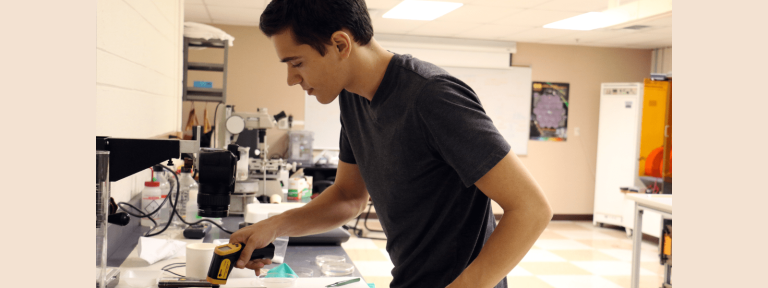
“For me it’s been incredibly valuable to have a broad range of experiences while I can. I think it should be something people should consider. You’re here to learn.”
Jason Chapman ‘17 will walk out of Kettering University with skills he didn’t know he would get as an undergraduate student.
Even though Chapman was a Mechanical Engineering major, he learned how to properly conduct X-Ray Diffraction, design research methods, handle chemicals safely and more Chemistry and Physics principles than he thought he would.
It was all thanks to his involvement in an undergraduate research opportunity with Dr. Uma Ramabadran in the Physics department.
“For me it’s been incredibly valuable to have a broad range of experiences while I can. It was good to explore,” Chapman said. “I think it should be something people should consider. You’re here to learn.”
Ramabadran and Dr. Gillian Ryan in the Department of Physics began collaborating in 2015 to explore possibilities to slow down the phase transition from liquid to solid (crystallization), which will in turn slow the rate at which heat is released. The research first started with a partnership with Warmilu, an Ann Arbor startup that provides incubated blankets to villages in India that lack electricity.
The technology behind the heated blanket is a more sophisticated version of pocket warmers that can be easily found at local pharmacies and placed in shoes and gloves for added warmth. Warmilu has emulated that science to create a prototype blanket that can maintain warmth for approximately five hours. Ramabadran and Ryan are attempting to cap the maximum temperature the blanket will attain and extend the duration of warmth beyond five hours.
There’s a mixture of material in a polymer pouch that is first boiled in water. Once boiled, the pouch is fitted into a blanket and activated by snapping a metal switch which causes a phase transformation from liquid to solid and the consequent release of heat to warm the blanket.
By studying the impact of parameters such as pH and different inorganic and organic additives, students are trying to slow down the crystal growth in order to release heat over a longer period of time.
Crystal growth fronts are tracked using high speed video cameras and analyzed using appropriate software. From this crystal growth rates are extracted.
For Ramabadran it was important to get Kettering students involved in the research to allow them hands-on experience and opportunities.
“I really enjoy working with students and watching them develop from a beginner to an independent researcher. These skills will be valuable to them in the future whether they work in product development, engineering or research,” Ramabadran said.
“I think the students are learning a lot from this project. They get their hands on high speed image analyzing software. They are trained on X-Ray diffraction and analysis of the data, as well as how to properly handle chemicals. They gain experience and confidence moving forward.”
Ramabadran has encouraged her on-campus thesis students to also present at conferences.
On this research project, Ramabadran has worked with four undergraduate students, allowing them to get crucial experience before graduating.
Once the students, Ramabadran and Ryan learn more about slowing the crystallization process, the results could be used for many other applications.
“We are using it for a specific purpose here, but what we learn from this could be useful in developing tunable phase change materials,” Ramabadran said. “Think of thermal energy heating. This could release the heat when you don’t have solar.”